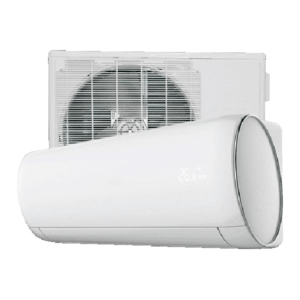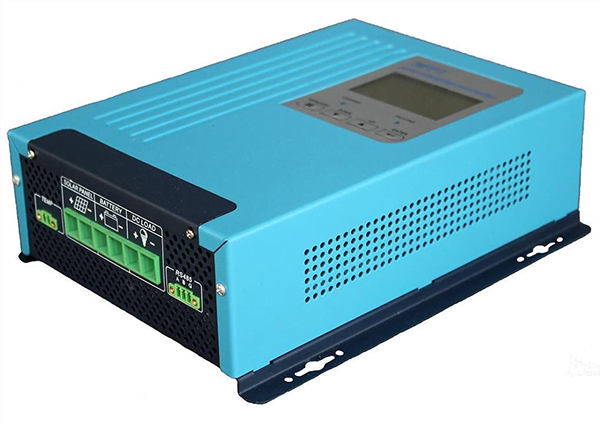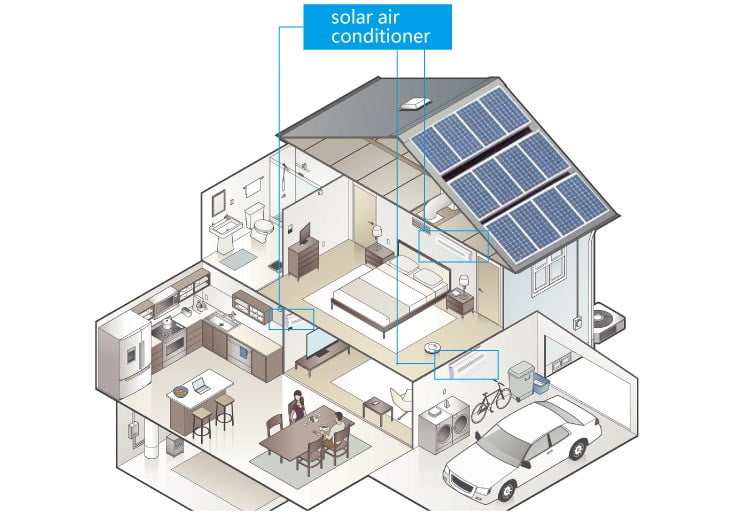Solar Powered Air Conditioner For Home Portable Split
Compare with the regular air conditioner, the investment increases 50%-80%, but the electricity bill will reduce 60-80% yearly.
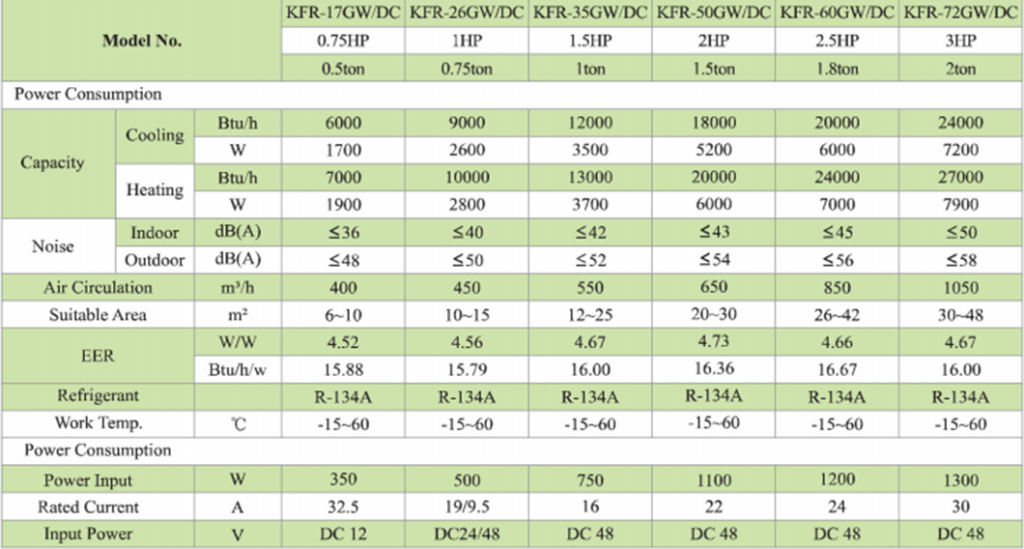
Equipment & Detailed
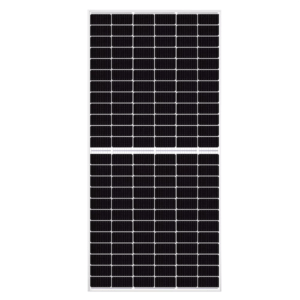 Solar Panels
Solar Panels
- 25 years Warranty
- Highest conversion efficiency of 17%
- Anti-reflective and anti-soiling surface power
loss from dirt and dust - Excellent mechanical load resistance
- PID Resistant, High salt and ammonia resistance
A/C UNIT
- AC/DC Hybrid Indoor Unit Available Capacity 9k, 12k, 18k, 24k Btu ; Digital display
- AC/DC Hybrid Outdoor Unit AC Input 180~240V 50/60HZ; R410A;
Low Noise 53~60dB - Full DC Inverter A/C Unit
- Eco Friendly R410A
GEL Battery
- 12V 200AH
- Deep Cycle
- 100% DOD Over 2200 times
Charge Controller
- For solar power system
- 12/24/36/48V DC Voltage
- 20/40/60/80A
- 5 Years Warranty
Choose which plan?
The first plan
Advantages
1. when the sun is full, Batteries can store 15KH power.
2. when it’s cloudy and rainy, batteries can still supply electricity.
Disadvantages
1. High price
The second plan
Advantages
1. low price
Disadvantages
1. only 5kwh can be stored.
2. there may be no electricity on rainy days.
The third plan
Advantages
1. low price
2. Just for one rainy day power storage
How does a solar air conditioner works:
- In simple terms, solar ACs use solar panels to power the air conditioning system.
- Solar panels collect energy from the sun. They convert this energy into power. That power either goes directly to the air conditioner or to a battery where it’s stored until the AC needs it.
- Most solar AC systems are hybrid, meaning they use traditional electricity sources in addition to solar power. Hybrid systems are more popular in very hot environments where it’s necessary to run the AC at night (when there’s no sun) to keep comfortable.
- For complete off-the-grid air conditioning, there are solar-only systems. These are more energy-efficient but don’t offer the same flexibility as hybrid systems.
- In simple terms, solar ACs use solar panels to power the air conditioning system.
Types of Solar-Powered Air Conditioners
Conditioners come in three types: DC current, AC current, and hybrids that can run on both types of power.
-
DC units
Solar panels output DC power. So if the air conditioner fan and compressor have DC motors, they can use that power directly. Such units typically operate at 12, 24 or 48 volts.
-
AC units
These utilize the 120-volt AC signal from the power grid. They can operate directly from a solar panel, but the panel signal has to first pass through an inverter, which reduces efficiency.
-
Hybrid units
These use DC and AC signals. They can draw directly from the panels when the sun is out, and from the power grid when it's not.
Solar Powered Air Conditioning Options
Even with solar-powered air conditioners, there are a few different options available. These differ based on the mode of power that the air conditioner is getting. Let’s see them below.
- DC-Powered Solar Air Conditioners
- AC-Powered Solar Air Conditioners
- Hybrid Powered Solar Air Conditioners
How Many Solar Panels Do I Need for Solar Air Conditioning?
The number of solar panels you need to run your solar air conditioning system depends on a few key factors:
- Your home’s overall energy consumption
- Your solar panels’ output and efficiency
- The amount of annual sunlight your home receives
- At a minimum, your rooftop solar panel system should generate enough energy to offset the power consumption of your air conditioner. For instance, if your air conditioner requires 900 watts of power, you would need three solar panels rated at 300 watts each.
- If you want to power your entire home (including the air conditioner) with renewable energy, you must install enough solar panels to cover the entire property’s electrical load. To calculate this, take a look at your utility bills to see the amount of electricity your home consumes annually (in kWh).
As an example, let’s say you use an average of 1,000 kWh per month. This means that your solar energy system would have to generate approximately 33 kWh daily (1000 kWh divided by 30) or 1,390 watts per hour (33kWh divided by 24 hours x 1000). - In areas with 6 hours of peak sunlight, you would then have to generate approximately 8,340 watt-hours daily (6 x 1,390) to cover the entire electrical load. With 400W modules, this means you should install approximately 21 solar panels (8,340Wh divided by 400W) to power your entire home and air conditioning system.
On Grid Solar Air Conditioner
ACDC On grid solar air conditioner with wall split type, cassette type, floor ceiling type, duct type, multi-split type and T3 type. High efficiency up to SEER36, high quality with 3-5 years warranty, convenient installation, wide voltage design, free combination of solar panels. All climate condition available.
Off Grid Solar Air Conditioner
48V Wall Split DC Solar Powered Air Conditioner with full DC 3D control (adopt world well-known DC compressor, DC indoor fan motor, DC outdoor fan motor), reliable running and high efficiency. easy installation, direct PV 48V powered, no conversion process. All climate and power supply available.
On/Off Grid Solar Air Conditioner
On/Off Grid Wall Split Type Solar Air Conditioner works perfectly under AC only, DC only or AC+DC, high SEER, wide voltage design, works perfectly under normal and T3 tropical climate. Equipped with MPPT PV tracking system, utilize the PV DC power as priority. DC directly power the indoor & outdoor fan motors and the compressor. Wide voltage design, freely use different PV panel configuration according to your installation space.
Our 24000btu Solar Air Conditioner is the perfect solution for people who live around the tropics and areas which suffered from heat from the sunlight. Also, in the high-dimensional region, the sunshine duration in summer would be much longer than the normal region, further, in this particular time of the greenhouse effect, global temperature has continually increased in the past decades. Summer with sunshine heating and high temperature has been a nightmare to people who live in the high-dimensional region.
Core Technology:
- APP smart control, easy to get the meter and data
- T3 Tropical 58 degree working
- MC4 connector for solar easy installation
- Compressor All-in-one packaging design
- Brushless DC motor drive technology
